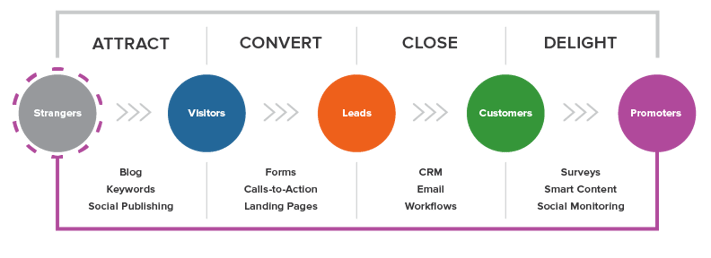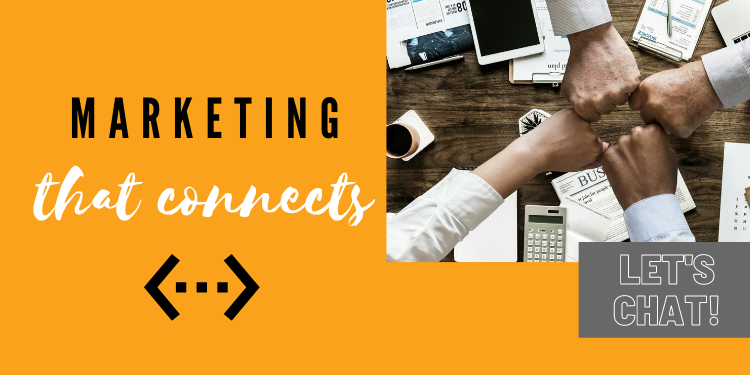Starting a business is exciting, however, having the best product doesn’t guarantee you the sales. To succeed in the highly competitive startup space, you need to choose the best-fit marketing strategy that aligns with your limited resources and attract the right prospects to your product or brand. As a young company ourselves, we recommend inbound marketing for your startup business.Unlike traditional buying ads, emails or cold calling, inbound marketing focuses on attracting ideal customers (a.k.a buyer personas) to your business through educational content and creating value at each stage of the buying journey.
Let’s have a look how the inbound marketing can help your startup business grow step by step.
 (Source: HubSpot)
(Source: HubSpot)
Typically, the inbound marketing for startups is broken into Attract, Convert, Close and Delight four steps.
Step 1: Attract more website visitors
Website traffic means a lot to a startup business. To drive traffic to your website, you need to understand your target audience and provide the content useful to them. Here are some tips for you to attract more website visitors.
Tip 1. Understand and define your persona
Buyer personas are semi-fictional, holistic ideals of your ideal customers. Understanding your ideal customers of who they are, what they do, what their frustrations and goals are would help you spend marketing resources on focused targets and make the most of their interactions with your brand.
Tip 2. Analyse the buyer’s journey
The buyer’s journey is the process buyers go through the awareness, consideration, and decision stages. It starts with buyers realising their problems, defining their problems and researching for possible solutions and finally choosing a solution. You can personalise your marketing and sales process to the buyer’s context by understanding the buyer’s journey.
Tip 3. Design a growth-driven website
Your website is the information hub of your business and the most important digital presence. But, does your website bring you customers? If not, then you need to consider a different approach to design your website.Try Growth-driven Design. Unlike the traditional website designing which is expensive and time-consuming, the Growth-Driven Design is a smarter, more agile approach that will produce better results with little risk.
Tip 4. SEO and blog marketing
Keywords are at the heart of SEO, and digital content should associate with these keywords. To create an SEO strategy, firstly list the keywords that your personas may search and build web pages tailored to those keywords.
Blogging is the key to inbound marketing. Research shows that on average, company blogs generate 55% more website visitors, 97% more inbound links and 434% more indexed pages. To create some killer blog posts, you need to put yourself in the shoes of your persona, write the things they would be interested in and don’t forget to include relevant keywords where appropriate. Read our blog to find more tips about blog marketing for business.
If you a HubSpot user, we also prepared three simple steps to help you optimise your blog posts.
Step 2: Convert the website visitors into leads
After attracting enough website visitors, now you need to create a conversion process to gather information of those prospects and convert them into sales qualified leads.
Conversion process typically involves having a Calls-to-Action(CTAs). CTA is a noticeable, clickable button linking to a content offer that prospects receive in return for their contact information. It can be placed on your website pages, your blog and in your emails. When a visitor clicks on the CTA, they will be brought to a landing page where they fill out a form with their contact information. After that, the visitor which is a lead now is directed to a thank you page where they will download the content offer.
If you have a HubSpot Pro or Enterprise account, you can use Smart Calls-to-Action (CTAs) to personalise your messaging according to who is on the website and what buying stage they are at.
Step 3. Close the leads into customers
Sales and marketing alignment makes inbound marketing methodology effective and efficient to business. Smarketing, Email marketing and CRM makes the sales and marketing alignment process possible.
1. Smarketing
![]() In the early years of a startup, everyone in the company should be selling & marketing.”
In the early years of a startup, everyone in the company should be selling & marketing.”
—Dharmesh Shah
Smarketing is the process of aligning both the sales and marketing around common goals, focused on improving revenue.
The sales and marketing funnel maps out how you want your personas to move through the buyer's journey. Defining your sales and marketing funnel is important because:
- Defines the action(s) you want leads to take at each stage, from visitor to customer
- Guides lead nurturing tactics
- Allows you to analyse your buyer's journey and conversion paths
- Gives clarity to the handover of leads between marketing and sales
- Helps to ensure that sales are given quality leads who are ready to buy
2. Email marketing
Email is versatile, it’s primary function is to nurture the leads into customers, but it can also be used to delight your customers as well. At the close stage, nurturing is all about sending the right email to the right audience at the right time. Providing your leads with helpful content and build a rapport. Here are 6 simple guidelines that you can apply to your campaign to increase clicks and engagement.
- Personalise your emails
- Resend emails to non-opens
- Offer free stuff
- Email at the right time
- Optimise for mobile devices
- Email consistently and regularly
3. Customer Relationship Management (CRM)
Crucial to making the most of the sales team is the use of an effective CRM. Customer experience is paramount to everything we do, especially with selling. Whether your goal is to improve brand recall or increase leads via your website, building a relationship and connecting your brand to your website visitors is key.
HubSpot's growth stack is an ideal way to help you grow with a clean way to reach, connect and sell to a customer.
Step 4. Delight customers
It costs more than six times to acquire a new customer than retain an existing customer. Delighting the existing customer is critical as it’s a way for you to take those customers and transition them into promoters. Customer success as a function is not just customer support or customer service, it’s a combination of marketing, sales, customer support and customer service. Here are some tips for your startup business to delight customers in an inbound way:
Tip 1. Build trust
Focus on building trust every interaction with your personas, leads and customers. Communicating with them to find out their needs and providing truthful and helpful content to them.
Tip 2. Delight your team
![]() Customers will never love a company until the employees love it first.”
Customers will never love a company until the employees love it first.”
—Simon Sinek
Happy team members create happy customers. Building trust with your customers starts with building a genuine trust among the people you work with.
Tip 3. Follow-up
When a business fails to follow-up with a customer, they risk losing the trust they’ve developed. Make sure that your team is not just resolving customers’ problems but also is ready to follow-up with any requests they may have in the future.
Although startup marketing might be complex, following the inbound methodology step by step will make it easier for you improve your performance achieve your sales goals in the most effective and efficient way.
Tags:
Marketing + Automation
January 11, 2018

